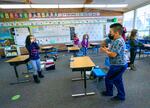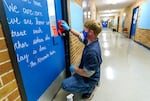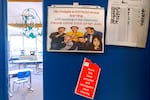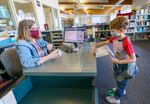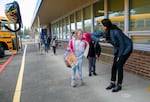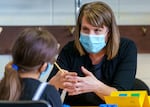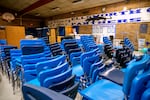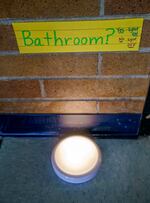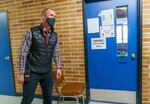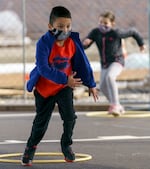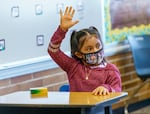
Teacher Stacie Walczyk, left, works with Alexandra Villegas-Lopez in class at Ellsworth Elementary School in Vancouver, Wash., March 1, 2021.
Kristyna Wentz-Graff / OPB
With just a few months left in a school year completely changed by COVID-19, more and more school districts are bringing students back to campuses on a part-time basis. Others have offered in-person instruction since the fall.
At last count, roughly 160,000 of Oregon’s school children were learning in person part of their school day — less than one-third of the total number of students in Oregon. To push that number upward, Gov. Kate Brown announced an executive order Friday directing public schools to open for elementary students on or before March 29, and for middle and high school students, April 19.
For the vast majority of schools affected, hybrid learning is likely to be their approach. Every school does hybrid learning a little differently, and not every family is excited by the prospect of a return to in-person school. But for those students and staff who do return to school buildings, they can expect an environment quite different from the one they left behind in March 2020.
In Evergreen, hybrid means learning in person — at a distance from other students
All elementary students in Evergreen Public Schools in Vancouver have had the option of hybrid learning since Feb. 1.
Alex Schiewe is principal at Evergreen’s Ellsworth Elementary, a school that’s had students in the building since October. He said students caught on to school changes pretty quickly.
“We obviously have reminders, sometimes, but our kids do really well,” Schiewe said. “It’s just like teaching any other expectation. Our teachers teach those expectations, and our kids do them.”
Around the school, markings on the ground serve as reminders of physical distancing rules; water fountains are taped up, and there are stations that dispense hand sanitizer if you step down on a pedal. A custodian walks around the building, cleaning frequently touched surfaces like door knobs, and prioritizing classrooms with a red tag on the door.
Ellsworth isn’t like a lot of other schools. It’s an old building. In some districts, concerns about the age of buildings and their environmental liabilities and poor ventilation systems have teachers and parents worried about reopening during the pandemic.
At Ellsworth Elementary, the building’s older features surprisingly help make sticking to COVID-19 protocol a little easier. Windows can open, and each classroom has a door to the outside. Instead of crowding the hallways, most traveling is done outside. Classrooms are large, and allow for socially distanced desks and carpet space.
The school conditions have given third-grade teacher Emily Schatz peace of mind about being back in the classroom.
“I was so tired of staring at a screen, trying to get to know my students, and I could see that their motivation was fading, so yeah, being back in person is amazing,” Schatz said.
“I feel very safe here at our school, at Ellsworth, being such a big classroom, and we have windows and doors that we can use.”
Inside one classroom, students take turns reading out loud. In another class, all but a couple of students work quietly, while their teacher works one on one with a student, practicing math. Teacher and student wear masks and look at each other across a table, in a consultation reminiscent of daily interactions that used to happen in classrooms everywhere, all the time.
In another classroom of older students, a teacher roams around the room, looking over students while they work — one of numerous teacher habits that are pretty hard to replicate in remote learning.
But there are constant small reminders that this learning is happening amid a pandemic.
Beyond the masks and the distancing, new structures have been added to mitigate risks of in-person school. Ellsworth’s main office is outfitted with plexiglass dividers. Students are expected to step on a button by the classroom door if they have to use the restroom, so that the school knows who’s in which bathroom, in case they later have to contact trace a positive COVID-19 case. In the library, students check out books and place them in plastic bags that help library staff know how long a book needs to be “quarantined” after it’s returned.
At recess, students can’t just chase each other like they would before. Instead, at Ellsworth they play a game facilitated by a teacher, staying in a circle of personal space. In gym class, students dance and jump around in personal squares set by red tape on the ground, kicking a disc back and forth.
“I shouldn’t be surprised at how creative teachers are to handle situations, like PE,” said Gail Spolar, director of community relations for the district.
“We all know what PE looked like, and yet, here’s a teacher who still made it fun and active, and music’s going, and they’re still in their little squares.”
Ellsworth’s hybrid school day didn’t always look like this, said Schiewe. The school started with shorter days, and there is continued tweaking if something isn’t working, or if staff doesn’t feel safe. The school’s youngest students have been in the building since the fall, which has given Ellsworth months to perfect its practices.
“We figure out what works, and then if it doesn’t, we adjust, and have to pivot to another direction,” Schiewe said. “It’s all about getting kids back in schools.”
The school has not had any COVID-19 outbreaks, according to district reporting to Clark County Public Health.
Evergreen Public Schools says about 74% of elementary students are in the hybrid model. The rest of students continue to attend school remotely. At Ellsworth, each grade level has one teacher who only teaches remote students.
Being at home hasn’t reduced the quality of education students receive, said Ellsworth administrators. It’s actually had the opposite effect.
“Our remote teachers are now ahead of the classroom teachers because they have them four days a week, as opposed to two, and they can get through lessons more quickly,” said Ellsworth associate principal Nancy Frank.
In Evergreen, secondary students are back in a hybrid model, though some students have stayed remote.
And when it comes to hybrid, middle and high school is different. There are more students, and more movement from classroom to classroom.
“That was always our concern,” Evergreen Education Association president Bill Beville said of hybrid for secondary students. “The elementary model fits really well for the CDC recommendations for cohorting, where you’re only with those ... sometimes as small as nine kids.”
While teacher Schatz feels comfortable at her elementary school, she doesn’t feel the same way for her peers teaching older students.
“Middle school, high school teachers, I don’t feel like they should be back,” Schatz said. “They have upwards of 120 students. ... I only have 21 students that I’m exposed to every week.”
In negotiating a hybrid plan for middle and high school students, Beville said another point in planning related to providing instruction to in-person and remote students simultaneously.
“We allowed teachers to make that choice themselves, every teacher would determine if they were willing to do the simultaneous,” Beville said.
Simultaneous, or “simulcast” instruction requires a teacher to deliver instruction both to students in their classrooms, and those learning at home who are receiving lessons through a video feed. The approach has been met with some skepticism by teachers, including in Portland.
Beville said conversations around reopening have been “passionate,” and it’s been challenging to negotiate. But his goal is to make reopening as “safe” as possible.
“There just aren’t any simple answers. There are some things, you make it as safe as possible, but I’d hesitate to call any of it ‘safe’,” Beville said. “I try not to use that word.”
With almost 25,000 students, Evergreen is more similar to bigger Oregon districts like Portland, Beaverton, Salem-Keizer and Hillsboro. Of those districts, only Salem-Keizer is offering hybrid instruction now, though the other districts are planning to begin hybrid later this month or in early April.
Oregon has nearly 200 school districts. Many are small and rural, and have offered hybrid and fully in-person classes for much of the school year.
For small Oregon districts, more students in person
Like Ellsworth Elementary, Hilda Lahti Elementary in Astoria, Oregon, serves around 400 students, though Hilda Lahti goes all the way up to eighth grade.
But unlike Ellsworth and Evergreen, the Knappa School District, which includes Hilda Lahti Elementary, only serves about 500 students total.
All of the students in the district receive some in-person instruction, but that hasn’t been the case for the whole year.
“The only thing that is constant is change,” said Knappa Superintendent Bill Fritz.
Students in grades 4-8 started out in comprehensive distance learning, and there were brief schoolwide closures in the fall because of a COVID-19 outbreak at a local seafood plant.
Currently, students in kindergarten through eighth grade go to school every day. Like Ellsworth, Fritz said large classrooms make social distancing easier for elementary students.
High school students are in hybrid learning, in cohorts — small groups meant to allow for contact tracing and minimize potential spread of COVID-19. Most students attend school in person two days a week. At the high school, teachers use simulcast instruction.
“The students that aren’t at school on a given day, they’re able to participate with the students who are in school,” Fritz said. “There’s a screen in the classroom, and those students are visible to the students who are in the room, and they interact with one another.”
Schools follow protocols set by the Oregon Department of Education, and students spend the day six feet apart and wearing masks. Cafeterias are open for all grades, and in the high school cafeteria, students sit at desks instead of tables to maintain distance.
Fritz says while some elements of school look different, some things remain the same.
“Kids are kids, teachers are teachers, and learning is learning, and a lot of the things that go on in a typical school day are still going on for our students,” Fritz said.
“You still see joy and camaraderie and connection between children and teachers. Those things don’t change.”
On the other end of the state, the InterMountain Education Service District supports 19 school districts in Eastern Oregon. ESD superintendent Mark Mulvihill said all of the school districts his ESD serves are open for elementary students in some form.
“They are all open in hybrid, K-5,” Mulvihill said. “That may be half-day, may be full-day ... there is not a school any more that’s strictly in CDL [comprehensive distance learning].”
Some districts in his region have been open since August, Mulvihill said. But for larger districts in the area, like Pendleton, Mulvihill said reopening has been challenging.
“The larger the district, the tougher the situation,” Mulvihill said.
“The smaller districts have the ability and the culture if you will, to be open K-12 and meet the requirements.”
Both Fritz and Mulvihill said their districts maintain a remote program for families that aren’t ready to head back into the classroom.
“Our superintendents, from day one have said, “we’re going to try to open, we’re going to try to bring kids back, but for those who are not comfortable, we will have a full comprehensive distance learning option — multiple options available for you,” Mulvihill said.
“I feel like we’ve done a pretty balanced approach and it works for our local communities.”
Lessons learned
For Evergreen Education Association president Bill Beville, the most important thing in creating a collaborative hybrid plan is something you can’t build, or pay for.
“Good communication, that’s the actual answer,” Beville said. “Unfortunately, it’s one of those things you can’t go back and fix. ... It had to be fixed before COVID hit, where the staff trusts that their safety’s being protected.”
Another thing? Good, responsive plans, especially for those who might continue to do their job from home.
Both Mulvihill and Fritz also highlight the collaboration and relationship between districts and unions, and individual staff members.
“I celebrate how our staff have responded to this,” Mulvihill said.
They also applaud Brown’s move to vaccinate school staff, and ODE’s guidance for reopening.
Fritz, who said attendance in his district has increased, said trying hybrid leads to more confidence about getting back into classrooms.
“When teachers are able to get into the classroom with students and be successful in that and experience small degrees of success, they realize it can be done and they gain more confidence,” Fritz said.
“I think for some of the districts that have been out for a long time, maybe they’ve lost some of that confidence, which is inhibiting their ability to get back in school.”
With Gov. Brown’s latest announcement, ordering public schools to reopen by mid-April, staff and students may be heading back to school sooner rather than later.

